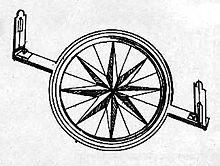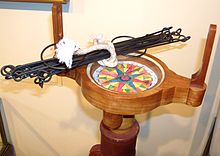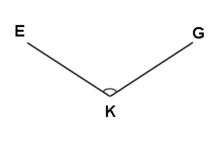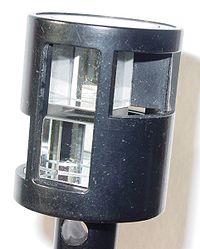- Circumferentor
-
A circumferentor, or surveyor's compass, is an instrument used in surveying to measure horizontal angles, now superseded by the theodolite. See also alidade.
It consists of a brass circle and an index, all of one piece. On the circle is a card, or compass, divided into 360 degrees; the meridian line of which is in the middle of the breadth of the index. On the circumference of the circle is a brass ring, which, with another ring fitted with glass, make a kind of box for the needle, which is suspended on a rivet in the center of the circle. On each extreme of the index is a sight. The whole apparatus is mounted on a staff, with a ball-and-socket joint for easy rotation.
Circumferentors were made throughout Europe, including England, France, Italy, and Holland. By the early 19th century, Europeans preferred theodolites to circumferentors. However, in America, and other wooded or uncleared areas, the circumferentor was still in common use.
Contents
Usage
 Figure 2: Region ABCDEFGHK
Figure 2: Region ABCDEFGHKMeasuring angles
To measure an angle with a circumferentor, such as angle EKG (Figure 1), place the instrument at K, with the fleur-de-lis in the card towards you. Then direct the sights, until through them you see E; and note the degree pointed at by the south end of the needle, such as 296°. Then, turn the instrument around, with the fleur-de-lis still towards you, and direct the sights to G; note the degree at which the south end of the needle point, such as 182°. Finally, subtract the lesser number, 182, from the greater, 296°; the remainder, 114°, is the number of degrees in the angle EKG.
If the remainder is more than 180 degrees, it must be subtracted from 360 degrees.
Surveying a region
To take the plot of a field, forest, park, etc, with a circumferentor, consider region ABCDEFGHK in Figure 2, an area to be surveyed.
- Placing the instrument at A, the fleur-de-lis towards you, direct the sights to B; where suppose the south end of the needle cuts 191°; and the ditch, wall, or hedge, measuring with a Gunter's chain, contains 10 chains, 75 links.
- Placing the instrument at B, direct the sights as before to C; the south end of the needle, e.g. will cut 279°; and the line BC contains 6 chains and 83 links.
Then move the instrument to C; turn the sights to measure D, and measure CD as before. In the same manner, proceed to D, E, F, G, H, and lastly to K; still noting the degrees of every bearing, or angle, and the distances of every side. This will result in a table of the following form:
Station Degrees Min. Chains Link A 191 00 10 75 B 297 00 6 83 C 216 30 7 82 etc. From this table, the field is to be plotted, or protracted.
Surveyor's double prism
A double prism is a device to measure right angles, consisting of two five sided prisms stacked on top of each other and a plumb-bob. it is used to stake out right angles, for example on a construction site.
See also
References
 This article incorporates content from the 1728 Cyclopaedia, a publication in the public domain.
This article incorporates content from the 1728 Cyclopaedia, a publication in the public domain.- Turner, Gerard L'E., "Circumferentor". Scientific Instruments, 1500-1900. University of California Press. ISBN 0-520-21728-4. 1998.
- "Circumferentor". Oxford English Dictionary. Oxford University Press. 2nd edition. 1989.
Categories:- Surveying instruments
Wikimedia Foundation. 2010.




